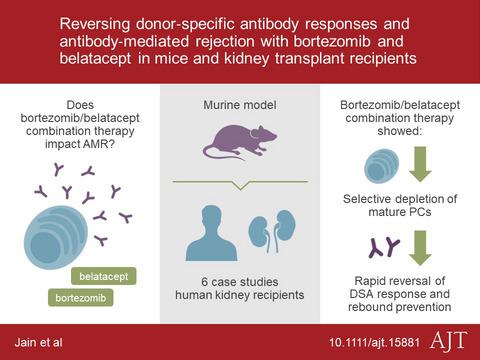当前位置:
X-MOL 学术
›
Am. J. Transplant.
›
论文详情
Our official English website, www.x-mol.net, welcomes your
feedback! (Note: you will need to create a separate account there.)
Reversing donor-specific antibody responses and antibody-mediated rejection with bortezomib and belatacept in mice and kidney transplant recipients.
American Journal of Transplantation ( IF 8.9 ) Pub Date : 2020-04-03 , DOI: 10.1111/ajt.15881 Dharmendra Jain 1 , Amer Rajab 2 , James S Young 1 , Dengping Yin 1 , Tibor Nadasdy 3 , Anita S Chong 1 , Ronald P Pelletier 2
American Journal of Transplantation ( IF 8.9 ) Pub Date : 2020-04-03 , DOI: 10.1111/ajt.15881 Dharmendra Jain 1 , Amer Rajab 2 , James S Young 1 , Dengping Yin 1 , Tibor Nadasdy 3 , Anita S Chong 1 , Ronald P Pelletier 2
Affiliation

|
Active antibody‐mediated rejection (AMR) is a potentially devastating complication and consistently effective treatment remains elusive. We hypothesized that the reversal of acute AMR requires rapid elimination of antibody‐secreting plasma cells (PC) with a proteasome inhibitor, bortezomib, followed by the sustained inhibition of PC generation with CTLA4‐Ig or belatacept (B/B). We show in mice that B/B therapy selectively depleted mature PC producing donor‐specific antibodies (DSA) and reduced DSA, when administered after primary and secondary DSA responses had been established. A pilot investigation was initiated to treat six consecutive patients with active AMR with B/B. Compassionate use of this regimen was initiated for the first patient who developed early, severe acute AMR that did not respond to steroids, plasmapheresis, and intravenous immunoglobulin after his third kidney transplant. B/B treatment resulted in a rapid reversal of AMR, leading us to treat five additional patients who also resolved their acute AMR episode and had sustained disappearance of circulating DSA for ≤30 months. This study provides a proof‐of‐principle demonstration that mouse models can identify mechanistically rational therapies for the clinic. Follow‐up investigations with a more stringent clinical design are warranted to test whether B/B improves on the standard of care for the treatment of acute AMR.
中文翻译:

在小鼠和肾移植受者中用硼替佐米和贝拉西普逆转供体特异性抗体反应和抗体介导的排斥反应。
主动抗体介导的排斥反应 (AMR) 是一种潜在的破坏性并发症,始终有效的治疗方法仍然难以捉摸。我们假设急性 AMR 的逆转需要用蛋白酶体抑制剂硼替佐米快速消除分泌抗体的浆细胞 (PC),然后用 CTLA4-Ig 或贝拉西普 (B/B) 持续抑制 PC 的产生。我们在小鼠身上发现,当在初级和次级 DSA 反应建立后施用时,B/B 疗法选择性地耗尽成熟 PC 产生供体特异性抗体 (DSA) 并减少 DSA。启动了一项试点研究,以使用 B/B 治疗六名连续的活动性 AMR 患者。对第一位早期出现严重急性 AMR 且对类固醇、血浆置换、第三次肾移植后静脉注射免疫球蛋白。B/B 治疗导致 AMR 迅速逆转,导致我们治疗了另外 5 名患者,这些患者的急性 AMR 发作也得到缓解,并且循环 DSA 持续消失≤30 个月。这项研究提供了一个原理验证证明,即小鼠模型可以为临床确定机械合理的疗法。有必要进行更严格的临床设计的后续调查,以测试 B/B 是否提高了急性 AMR 治疗的护理标准。这项研究提供了一个原理验证证明,即小鼠模型可以为临床确定机械合理的疗法。有必要进行更严格的临床设计的后续调查,以测试 B/B 是否提高了急性 AMR 治疗的护理标准。这项研究提供了一个原理验证证明,即小鼠模型可以为临床确定机械合理的疗法。有必要进行更严格的临床设计的后续调查,以测试 B/B 是否提高了急性 AMR 治疗的护理标准。
更新日期:2020-04-03
中文翻译:

在小鼠和肾移植受者中用硼替佐米和贝拉西普逆转供体特异性抗体反应和抗体介导的排斥反应。
主动抗体介导的排斥反应 (AMR) 是一种潜在的破坏性并发症,始终有效的治疗方法仍然难以捉摸。我们假设急性 AMR 的逆转需要用蛋白酶体抑制剂硼替佐米快速消除分泌抗体的浆细胞 (PC),然后用 CTLA4-Ig 或贝拉西普 (B/B) 持续抑制 PC 的产生。我们在小鼠身上发现,当在初级和次级 DSA 反应建立后施用时,B/B 疗法选择性地耗尽成熟 PC 产生供体特异性抗体 (DSA) 并减少 DSA。启动了一项试点研究,以使用 B/B 治疗六名连续的活动性 AMR 患者。对第一位早期出现严重急性 AMR 且对类固醇、血浆置换、第三次肾移植后静脉注射免疫球蛋白。B/B 治疗导致 AMR 迅速逆转,导致我们治疗了另外 5 名患者,这些患者的急性 AMR 发作也得到缓解,并且循环 DSA 持续消失≤30 个月。这项研究提供了一个原理验证证明,即小鼠模型可以为临床确定机械合理的疗法。有必要进行更严格的临床设计的后续调查,以测试 B/B 是否提高了急性 AMR 治疗的护理标准。这项研究提供了一个原理验证证明,即小鼠模型可以为临床确定机械合理的疗法。有必要进行更严格的临床设计的后续调查,以测试 B/B 是否提高了急性 AMR 治疗的护理标准。这项研究提供了一个原理验证证明,即小鼠模型可以为临床确定机械合理的疗法。有必要进行更严格的临床设计的后续调查,以测试 B/B 是否提高了急性 AMR 治疗的护理标准。











































 京公网安备 11010802027423号
京公网安备 11010802027423号